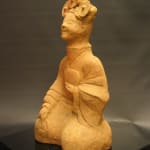Han Dynasty Painted Pottery 'Sichuan' Lady Holding a Mirror, 202 BCE - 220 CE
Terracotta
12.2 x 23.62
DL.1006
Further images
A type of work known as mingqi, literally translated as, “items for the next world,” this sculpture was specifically commissioned by the family of the deceased to be buried alongside...
A type of work known as mingqi, literally translated as, “items for the next world,” this sculpture was specifically commissioned by the family of the deceased to be buried alongside their departed relative, both as a symbol of their wealth and familial piety. However, only elite members of the social hierarchy could afford to be honored with such elaborate burials. During the Han era, the ancient Chinese believed that the afterlife was an extension of our earthly existence. Thus, the tombs of nobles and high-ranking officials were filled with sculpted renditions of their earthly entourage. Musicians, chefs, attendants, and guardians were placed alongside pots, vessels, cooking utensils, and herds of livestock. All these mingqi were expected to perform their functions continually throughout the afterlife.
The smile that graces the face of this delightful female attendant is typical of this genre of clay figurines produced in the Sichuan Province. The woman holds a mirror in her left hand, whilst her right hand rests upon her knee. She is seated on the ground with her legs tucked beneath her. Her hair has been arranged in an elaborate coiffure and is further adorned with three large medallions or stylized flowers. The artist, perhaps because he was portraying someone it was not appropriate to idealize or deify, captured the intimacy, vibrancy, and intensity of an actual woman. Locked in this bit of clay, a smile, a laugh, and a will to entertain are still apparent to a modern audience centuries after its creation.
The smile that graces the face of this delightful female attendant is typical of this genre of clay figurines produced in the Sichuan Province. The woman holds a mirror in her left hand, whilst her right hand rests upon her knee. She is seated on the ground with her legs tucked beneath her. Her hair has been arranged in an elaborate coiffure and is further adorned with three large medallions or stylized flowers. The artist, perhaps because he was portraying someone it was not appropriate to idealize or deify, captured the intimacy, vibrancy, and intensity of an actual woman. Locked in this bit of clay, a smile, a laugh, and a will to entertain are still apparent to a modern audience centuries after its creation.





